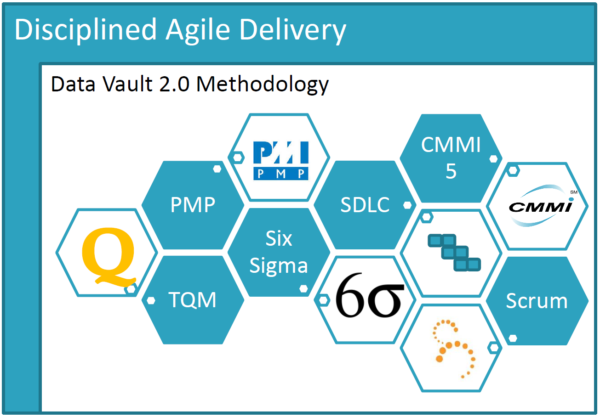Looking beyond Scrum and learn how to increase the value in Data Vault 2.0 projects
Earlier this year we talked about Managed Self-Service BI to explain how business users can take a benefit from this approach in Data Vault 2.0. Now we want to show you how to get there from a project management perspective, even in large companies where the standard Scrum approach often not works with the accorded deployment/release regulations and other approaches like the Disciplined Agile framework are the better fit.
Agile transformation is hard because cultural change is hard. It’s not one problem that needs to be solved, but a series of hundreds of decisions affecting lots of people over a long period of time that affects relationships, processes, and even the state of mind of those working within the change.
There are two fundamental visions about what it means to scale agile: Tailoring agile strategies to address the scaling challenges – such as geographic distribution, regulatory compliance, and large team size – faced by development teams and adopting agility across your organization. Both visions are important, but if you can’t successfully perform the former then there is little hope that you’ll be successful at the latter.
Data Vault 2.0 and Disciplined Agile Delivery
Many organizations start their agile journey by adopting Scrum because it describes a good strategy for leading agile software teams. However, Scrum is only a part of what is required to deliver sophisticated solutions to your stakeholders. Invariably teams need to look to other methods to fill in the process gaps that Scrum purposely ignores. Mainstream agile methods provide a great starting point but require significant effort to make them scalable.
To address these challenges the Disciplined Agile Delivery (DAD) process decision framework provides a more cohesive approach to agile solution delivery.
“The Disciplined Agile Delivery (DAD) process decision framework is a people-first, learning-oriented hybrid agile approach to IT solution delivery. It has a risk-value delivery lifecycle, is goal-driven, is enterprise aware, and is scalable.”1
DAD promotes a full end-to-end delivery lifecycle from team initiation all the way to deliver the solution to your stakeholders.

Another issue with Scrum is that a deployment is typically performed at the end of a two to four week Scrum sprint, resulting in deploy a usable piece of “working software”. However, some (if not many) enterprise organizations are unable to deploy new functionality every two to four weeks into production.
If deployments in your organization can’t be done in an agile Data Vault 2.0 sprint, DAD is the answer which is fully adapted in the Data Vault 2.0 concept including the methods like Scrum, CMMI, Six Sigma, and more.

Instead of deploying new functionality after every iteration, new functionality is “bundled” by every iteration into a change set that is deployed at the end of a release. Typically, a release has a fixed length again, but consists of a longer duration, e.g. a quarterly release would produce 4 releases a year. Each release consists of three phases (Inception, Construction and Transition phase), whereby each phase consists of multiple Data Vault 2.0 iterations.
Governance establishes chains of responsibility, authority and communication in support of the overall enterprise’s goals and strategy. It also establishes measurements, policies, standards and control mechanisms to enable people to carry out their roles and responsibilities effectively. You do this by balancing risk versus return on investment (ROI), setting in place effective processes and practices, defining the direction and goals for the department, and defining the roles that people play with and within the department.
1 https://www.disciplinedagileconsortium.org/Disciplined-Agile-DAD


A very useful article and source for learning such high-quality information! I appreciate you sharing this useful information.